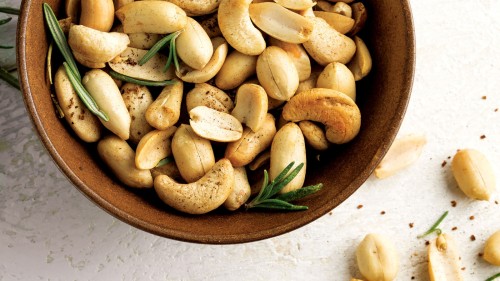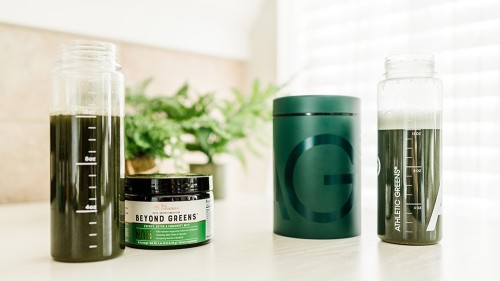Healthiest Leafy Green Vegetables, Their Benefits, and Tips on How to Use Them More Often
Published on January 7, 2022
Medically Reviewed by Ana Reisdorf, MS, RD
Despite being the healthiest of foods, green vegetables have acquired an unfortunate reputation of being the least favorite food among children and adults alike. But there are many ways you can add leafy greens to your day without compromising the taste of your food.


Whether it’s the image of children pushing their peas onto the floor for the dog, or stories from older generations gagging down canned Brussels sprouts as kids, green vegetables don’t exactly scream, “I’m delicious!”.
But what if that’s not the whole story when it comes to green leafy vegetables?
The truth is that leafy greens are among the healthiest foods on the entire planet, and many countries outside of western cultures eat them on a daily basis.
It’s also true that leafy green vegetables can be an acquired taste, even well into adulthood, but the effort is worthwhile.
Understanding how to prepare them in ways that bring out their best flavors and textures, as well as the incredible health benefits they offer, can help you practice adding more leafy green vegetables to your lifestyle.
Why Eat Leafy Greens?
Leafy greens are incredibly good for you. They’re packed with nutrients and plant compounds that offer numerous benefits for your health.
For instance, leafy green vegetables are generally high in the following nutrients:
In addition to vitamins and minerals, leafy greens are rich in antioxidants, compounds that help protect your cells from oxidative damage that can encourage diseases.
They also contain phytochemicals (a fancy word for “plant chemicals”) with disease-fighting properties. Some of these include phylloquinone, lutein, nitrate, folate, alpha-tocopherol, and kaempferol.
Furthermore, eating leafy greens has been scientifically proven to be one of the best preventive health habits you can practice. Some of the reasons for this are discussed below.
Brain Health
A 2018 observational study published in the journal Neurology conducted food frequency questionnaires and cognitive assessments among 960 older participants from the Memory and Aging Project, with data collected over an average of 4.7 years. (1)
The authors found that consuming an average of one serving of leafy green vegetables per day may help slow cognitive decline, which is common with age.
Outcomes were adjusted for factors like age, sex, education, participation in cognitive activities, physical activities, smoking, and consumption of seafood and alcohol.
What’s even more impressive, though, is that the rate of cognitive decline for those who consumed at least 1.3 servings of leafy green veggies per day was the equivalent of being 11 years younger in age, compared to the other participants.
Furthermore, leafy greens have been found to have natural antidepressant properties, being ranked among the best plant foods for preventing and treating depressive disorders. (2)
Summary
Green leafy vegetables are essential for preventing cognitive decline and supporting a healthy mood.
Immune Function
In a 2011 animal study published in the journal Cell, researchers found that green vegetables may hold a key to the proper functioning of your immune system. (3)
This appears to be because they make sure immune cells in your gut and skin, called intraepithelial lymphocytes (IELs), are working as they’re supposed to be.
IELs are considered a first line of defense in wound repair because of their location throughout the body.
Leafy greens are packed with nutrients that can help support a healthy immune response.
For instance, not getting enough vitamin C is associated with a higher risk for illnesses and infections. (4)
Other micronutrients linked to immune function, such as vitamins A and E, iron, and B vitamins, can also be found in a variety of greens. (5)
Summary
Green vegetables are loaded with nutrients required for a healthy immune system.
Bone Health
Dairy products may get the limelight when it comes to bone health, but leafy greens are an unsung hero in this department.
Not only are they a good source of calcium, but they’re also rich in other nutrients necessary for bone metabolism and maintenance, like potassium and vitamin K1.
A 2020 study published in the journal Bone Reports followed 30 middle-aged individuals to assess the effects of eating two to three extra servings of green leafy vegetables per day on their bone metabolism. (6)
The authors found that those who consumed the most greens experienced an increased entry of osteoclasts into their bone matrix.
In other words, the additional vitamin K1 from the extra leafy greens appeared to substantially affect bone metabolism and support their skeletal health.
Another perk was that increasing the daily servings of greens was perceived to be pretty easy for participants.
Summary
Eating more green vegetables helps protect bones, as they contain several vitamins and minerals needed for bone health.
Gut Health
Much of your immune response begins in your digestive tract, so it’s important to feed your gut well.
This means eating in a way that fuels the good bacteria and helps weed out the bad ones. Leafy greens are a great food to help promote a happy gut. (7)
Why? Leafy greens are full of fiber, a nutrient that helps promote bowel regularity and a clean digestive system, as well as reduce your risk for various chronic diseases. (8)
For instance, as fiber is fermented in your gut, short-chain fatty acids are produced that appear to be essential for maintaining a healthy microbiome. (9)
Plus, in a 2013 study published in the journal Nature Immunology, researchers found that leafy greens may control a population of immune cells, called innate lymphoid cells (ILCs), that are critical for intestinal health. (10)
ILCs help repair small wounds in the gut, as well as encourage the growth of good gut bacteria.
Having a healthy population of ILCs also appears to be necessary for controlling food allergies, obesity, inflammatory diseases, and potentially even preventing bowel cancers. (11)
Summary
Leafy greens are a good source of fiber that supports gut health. They also help regulate specific immune cells that keep the digestive tract healthy.
Related: 10 Evidence-Based Ways to Improve Your Gut Health
10 Healthiest Leafy Green Vegetables
Leafy green vegetables are so much more than a big bowl of salad. Below are some of the healthiest green vegetables you ever did see, plus some delicious ways to make them a more regular part of your diet.
1. Kale
Kale has had its time in the “superfoods” sun, and for a good reason.
It’s a cruciferous vegetable, alongside cabbage, broccoli, cauliflower, and Brussels sprouts. And kale comes in various types, like purple, green, red, curly, or smooth.
Kale is particularly high in nutrients like vitamins A, C, and K, B6, manganese, calcium, copper, potassium, and magnesium. Like other greens, it’s low in calories and is a good source of fiber.
You’ll also get compounds like the flavonoids quercetin and kaempferol, as well as the antioxidants beta-carotene and vitamin C when you eat kale. A single cup of kale actually contains more vitamin C than an orange. (12)
Studies have found that kale may help increase HDL “good” cholesterol, lower LDL “bad” cholesterol, and improve heart health. (13)
Its cholesterol-lowering effects have been compared to those of the drug cholestyramine, which is often used for this purpose. (14)
Additionally, kale and other cruciferous vegetables are rich in the sulfur-containing compound sulforaphane, which has been studied for its cancer-preventing properties. (15, 16)
Put It Into Action
- Kale can be a little tough, so it’s best to chop it up into small pieces if consuming it raw and uncooked.
- Alternatively, you can massage kale with a bit of olive oil to help soften its leaves before eating it.
- Try adding kale to mixed green salads, grain dishes and bowls, smoothies, or roasting it in the oven or air fryer to make seasoned kale chips.
2. Romaine Lettuce
Romaine lettuce is one of the most common lettuce out there, often showing up in restaurant salads and sandwiches alike. It has a neutral flavor, a soft texture, and comes in a variety of green and red shades.
Like other greens, romaine is a good source of fiber, vitamins A, C, and K, as well as phosphorus, magnesium, potassium, and folate.
Some research even suggests that romaine lettuce may help improve sleep, thanks to compounds called lactucin and lactucopicrin. (17, 18)
Put It Into Action
- Romaine lettuce makes a great foundation for mixed green salads, like Caesar salad.
- It also layers well in sandwiches, tacos, burritos, and wraps.
- You can even try cutting a head of romaine in half, brushing it with olive oil, and cooking it on the grill.
3. Spinach
Spinach is a popular leafy green that’s actually related to beets and quinoa. It’s known for its oval-shaped leaves and mild flavor and texture, making it very versatile in recipes.
Nutritionally, spinach is a good source of fiber, vitamins A, K1, and C, folate, calcium, and iron. It also contains an array of antioxidants and phytochemicals.
Two of the prominent antioxidants in spinach are called lutein and zeaxanthin, which are carotenoids that give certain fruits and vegetables their pigment and are known to benefit your eye health. (19)
Spinach also contains compounds called nitrates, which may be beneficial for your heart. Naturally-occurring nitrates, like those found in spinach, are metabolized into nitric oxide, a gas that helps promote healthy circulation. (20, 21)
Put It Into Action
- Raw spinach works well in salads, sandwiches, and wraps, as well as blended into smoothies.
- Try cooking spinach on the stove with a bit of olive oil and garlic until wilted for a delicious side dish.
- Frozen spinach can be thawed and used to make casseroles and dips.
4. Bok Choy
Bok choy is a type of Chinese white cabbage and is part of the cruciferous vegetable family. It resembles the heads of romaine in that it has a longer versus spherical shape.
Bok choy leaves are mostly white with green tips.
A one-cup serving of chopped bok choy offers 35% of your daily value for vitamin C. It’s also a good source of vitamins A and K1 and contains some fiber, calcium, iron, selenium, and manganese.
Some studies have found that eating bok choy may help lower the risk for certain cancers. (22)
This green leafy vegetable also contains compounds associated with better bone health, thyroid health, and heart health. (23, 24, 25)
Put It Into Action
- Bok choy can be finely diced and used in fried rice, incorporated into stir-fries, and chopped into a raw veggie salad.
- You might also enjoy slicing it lengthwise and roasting it in the oven drizzled with some olive oil, salt, and pepper.
5. Collard Greens
Collard greens are similar to kale in that they have a rougher texture, a firm stem, and belong to the cruciferous vegetable family. However, collards have longer, smoother, flat green leaves.
They’re rich in fiber, vitamins A, K1, and C, folate, calcium, iron, and antioxidants.
Like other cruciferous veggies, collard greens also contain compounds called glucosinolates. When these are broken down in your body, they are converted to isothiocyanate, which appears to have some anticancer characteristics. (26, 27)
Collard greens may be especially beneficial for your bone health, seeing as they offer over 800% of the daily value for vitamin K1 in just a one-cup serving cooked. (28)
Put It Into Action
- While collard greens can be eaten raw, like in smoothies or chopped into salads, they’re more often consumed sauteed or otherwise cooked.
- Try chopping and adding them to breakfast scrambles, pulverizing them into homemade pesto sauces, or adding them as a pizza topping.
- You can even season collard greens with a bit of olive oil and salt and roast them in the oven to make chips.
6. Swiss Chard
Swiss chard is similar to collard greens in that it has long, smooth, flat leaves, but its stalks are a little easier to eat.
You may have seen Swiss chard in both green and rainbow varieties, with colorful stems of purple, yellow, red, and orange.
Eating Swiss chard may offer heart health benefits.
For instance, one 2018 study among over 173,000 people found that for every single serving of leafy green vegetables consumed per day, including Swiss chard, participants experienced an 11% reduction in heart disease risk. (29)
And when people ate at least 1.5 servings per day, they had a 17% lower risk compared to individuals who ate the fewest greens.
Put It Into Action
- Add chopped Swiss chard to soups and stews, mixed green salads, and even smoothies.
- Swiss chard works well sauteed on the stove with olive oil and garlic and used as a side dish or added to pasta dishes.
- You can even make pickled Swiss chard stems for a snack.
7. Microgreens
Microgreens are simply the greens from young vegetable plants, such as broccoli, radish, mesclun, and beetroot.
They’re generally harvested between 7–21 days after germination and are 1–3 inches in height when ready to eat.
Nutritionally, microgreens are a good source of antioxidants. They also contain minerals like potassium, iron, zinc, magnesium, and copper, which may meet or exceed the amounts found in mature greens. (30, 31)
Some research suggests that the antioxidants in microgreens may offer protective benefits against diseases like cancer, Alzheimer’s dementia, diabetes, and heart disease. (32, 33, 34, 35)
Put It Into Action
- Add microgreens to any salad, layer them onto sandwiches, juice them, or blend them into your smoothies.
- You can also use them as garnishes in breakfast scrambles and omelets, on top of soups, or in warm pasta dishes and casseroles.
8. Arugula
Another cruciferous vegetable, arugula is known for its more bitter, peppery taste compared to other leafy greens.
Arugula contains fiber, vitamins A, K, and C, folate, calcium, potassium, and may be especially high in anticancer compounds. (36)
Put It Into Action
- Try arugula in a mixed green salad to add a unique flavor and texture.
- You might also enjoy it in wraps and sandwiches, on top of pizza or pasta dishes, or eaten on its own with a bit of olive oil, salt, and pepper.
9. Cabbage
Cabbage comes in a variety of colors, including red, purple, green, and white. While the head of cabbage looks similar to that of iceberg lettuce, it has a thicker texture and unique taste.
Red and purple cabbage are higher in anthocyanins, an antioxidant that gives plants pigments and likely offers heart health benefits. (37)
Cabbage is also rich in both soluble and insoluble fiber, which offers benefits for digestive health and bowel regularity, as well as normal immune function. (38, 39, 40)
Put It Into Action
- Try chopped cabbage in coleslaws or homemade kimchi and sauerkraut.
- Purple or red cabbage can also work well in mixed green salads with other lettuce varieties.
- You might also enjoy cooked cabbage in soups and stews.
10. Beet Greens
That’s right, the greens you usually throw out after preparing beets can also be eaten.
In fact, they’re high in antioxidants like beta-carotene and lutein, which may be especially beneficial for your eyes. (41)
Beet greens also have some potassium, calcium, riboflavin, vitamins A and K, and fiber.
Put It Into Action
After preparing your beets, wash and chop up the greens to add to soups, salads, or saute them in a pan with a bit of olive oil and garlic.
The Bottom Line
Leafy green vegetables are some of the healthiest foods you can eat. Fortunately, many of them are also relatively inexpensive and versatile, which is helpful if you’re not used to eating them and want to experiment.
Greens work well in salads, but can also be added to soups, stews, and stir-fries.
Try chopping them and sauteeing them on the stove with some oil and seasoning. Many leafy greens also work well blended into smoothies alongside fruits like pineapple and citrus.
Adding more leafy greens to your diet can be as simple as incorporating them into dishes you already eat and enjoy.
Plus, you gain the added nutritional and health benefits they have to offer in even a small serving.
At WellnessVerge, we only use reputable sources, including peer-reviewed medical journals and well-respected academic institutions.
- Nutrients and bioactives in green leafy vegetables and cognitive decline: Prospective study:
https://pubmed.ncbi.nlm.nih.gov/29263222/ - Antidepressant foods: An evidence-based nutrient profiling system for depression:
https://www.ncbi.nlm.nih.gov/pmc/articles/PMC6147775/ - Exogenous Stimuli Maintain Intraepithelial Lymphocytes via Aryl Hydrocarbon Receptor Activation:
https://www.cell.com/cell/fulltext/S0092-8674(11)01136-6? - Vitamin C and Immune Function:
https://pubmed.ncbi.nlm.nih.gov/29099763/ - Immune Function and Micronutrient Requirements Change over the Life Course:
https://pubmed.ncbi.nlm.nih.gov/30336639/ - The effects of vitamin K-rich green leafy vegetables on bone metabolism: A 4-week randomised controlled trial in middle-aged and older individuals:
https://pubmed.ncbi.nlm.nih.gov/32455149/ - Association of dietary fibre intake and gut microbiota in adults:
https://pubmed.ncbi.nlm.nih.gov/30355393/ - The Impact of Dietary Fiber on Gut Microbiota in Host Health and Disease:
https://pubmed.ncbi.nlm.nih.gov/29902436/ - Short chain fatty acids in human gut and metabolic health:
https://pubmed.ncbi.nlm.nih.gov/32865024/ - The transcription factor T-bet is essential for the development of NKp46+ innate lymphocytes via the Notch pathway:
https://www.nature.com/articles/ni.2545 - Gene discovery reveals importance of eating your greens:
https://www.sciencedaily.com/releases/2013/03/130304105658.htm - Characterization and quantification of flavonoids and hydroxycinnamic acids in curly kale (Brassica oleracea L. Convar. acephala Var. sabellica) by HPLC-DAD-ESI-MSn:
https://pubmed.ncbi.nlm.nih.gov/19253943/ - Kale Juice Improves Coronary Artery Disease Risk Factors in Hypercholesterolemic Men1:
https://www.sciencedirect.com/science/article/pii/S0895398808600124 - Steam cooking significantly improves in vitro bile acid binding of collard greens, kale, mustard greens, broccoli, green bell pepper, and cabbage:
https://www.sciencedirect.com/science/article/abs/pii/S027153170800064X - Dual roles of sulforaphane in cancer treatment:
https://pubmed.ncbi.nlm.nih.gov/22583415/ - Cruciferous vegetables and cancer prevention:
https://pubmed.ncbi.nlm.nih.gov/12094621/ - Effectiveness of the Sleep Enhancement by Green Romaine Lettuce (Lactuca sativa) in a Rodent Model:
https://pubmed.ncbi.nlm.nih.gov/31582660/ - Sleep-inducing effect of lettuce (Lactuca sativa) varieties on pentobarbital-induced sleep:
https://www.ncbi.nlm.nih.gov/pmc/articles/PMC6049580/ - Biologic mechanisms of the protective role of lutein and zeaxanthin in the eye:
https://pubmed.ncbi.nlm.nih.gov/12626691/ - Nitrite and nitrate: cardiovascular risk-benefit and metabolic effect:
https://pubmed.ncbi.nlm.nih.gov/21102328/ - The role of nitric oxide on endothelial function:
https://pubmed.ncbi.nlm.nih.gov/22112350/ - Cruciferous vegetables and cancer risk in a network of case-control studies:
https://pubmed.ncbi.nlm.nih.gov/22328735/ - Chronic iron deficiency as an emerging risk factor for osteoporosis: a hypothesis:
https://pubmed.ncbi.nlm.nih.gov/25849944/ - Selenium and the thyroid: A close-knit connection:
https://pubmed.ncbi.nlm.nih.gov/23565426/ - Potassium, magnesium, and calcium: their role in both the cause and treatment of hypertension:
https://pubmed.ncbi.nlm.nih.gov/18607145/ - Bioavailability of Glucosinolates and Their Breakdown Products: Impact of Processing:
https://www.ncbi.nlm.nih.gov/pmc/articles/PMC4985713/ - Natural Products as a Vital Source for the Discovery of Cancer Chemotherapeutic and Chemopreventive Agents:
https://pubmed.ncbi.nlm.nih.gov/26679767/ - USDA, FoodData Central: Collards, frozen, chopped, cooked, boiled, drained, without salt:
https://fdc.nal.usda.gov/fdc-app.html#/food-details/169996/nutrients - Cardiovascular Health Benefits of Specific Vegetable Types: A Narrative Review:
https://www.ncbi.nlm.nih.gov/pmc/articles/PMC5986475/ - Assessment of vitamin and carotenoid concentrations of emerging food products: edible microgreens:
https://pubmed.ncbi.nlm.nih.gov/22812633/ - Broccoli Microgreens: A Mineral-Rich Crop That Can Diversify Food Systems:
https://www.ncbi.nlm.nih.gov/pmc/articles/PMC5362588/ - Natural Polyphenols for Prevention and Treatment of Cancer:
https://www.ncbi.nlm.nih.gov/pmc/articles/PMC4997428/ - Dietary polyphenols for treatment of Alzheimer's disease--future research and development:
https://pubmed.ncbi.nlm.nih.gov/25312617/ - In vitro regulation of enzymatic release of glucose and its uptake by Fenugreek microgreen and Mint leaf extract:
https://ifst.onlinelibrary.wiley.com/doi/abs/10.1111/ijfs.13588 - Polyphenols, Inflammation, and Cardiovascular Disease:
https://www.ncbi.nlm.nih.gov/pmc/articles/PMC3651847/ - Erucin, the Major Isothiocyanate in Arugula (Eruca sativa), Inhibits Proliferation of MCF7 Tumor Cells by Suppressing Microtubule Dynamics:
https://www.ncbi.nlm.nih.gov/pmc/articles/PMC4065051/ - Anthocyanins in Cardiovascular Disease1:
https://www.ncbi.nlm.nih.gov/pmc/articles/PMC3042791/ - Fiber and Prebiotics: Mechanisms and Health Benefits:
https://www.ncbi.nlm.nih.gov/pmc/articles/PMC3705355/ - Effect of dietary fiber on constipation: A meta analysis:
https://www.ncbi.nlm.nih.gov/pmc/articles/PMC3544045/ - Immune Response to Bifidobacterium bifidum Strains Support Treg/Th17 Plasticity:
https://www.ncbi.nlm.nih.gov/pmc/articles/PMC3178565/ - Macular pigment response to a supplement containing meso-zeaxanthin, lutein and zeaxanthin:
https://pubmed.ncbi.nlm.nih.gov/17498306/






